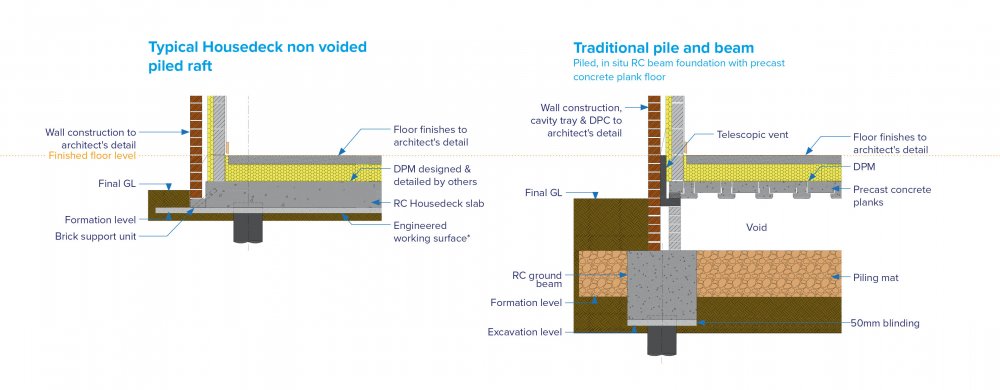With increasing demand to build on Brownfield sites, the use of piled foundations is rising. The higher costs of deep foundations reduce project viability for MMC however, there is a solution.
The majority of Brownfield sites require piling or other deep foundations due to the problematic ground conditions that have rendered it a Brownfield site, such as below surface building materials from its former use and pollutants. These undesirable ground conditions exclude the option for shallow foundation methods.
When piling is required, builders often default to traditional piled foundations, such as pile and beam. Such foundations are rarely cost-effective or time efficient for MMC builders, reducing project viability.
The primary downfalls of this approach are the time, cost and environmental impact of excavating for and constructing ground beams. A huge amount of contaminated spoil goes to landfills, and a considerable amount of concrete is used, at great cost to the builder and the environment. These processes also add unnecessary time to the programme. And as modular and prefabricated buildings are lighter than traditional methods, pile and beam often provide an over-engineered solution, adding further unnecessary costs and time into the scheme.
With a focus on the needs of MMC, programme, cost, tolerances and environment, the ground engineering specialists at Abbey Pynford have a different approach.
They have developed two adaptive piled foundation systems that bypass the issues of pile and beam foundations for both volumetric construction and frame-based systems.
Piled foundations for frame MMC
For frame-based projects that require an integrated ground floor system, the engineers at Abbey Pynford have a solution, their patented piled raft and ground floor foundations.
The proprietary raft systems by Abbey Pynford sidesteps the aforementioned issues associated with traditional piled foundations. The raft system uses significantly fewer materials, as it does not require ground beams, precast floors, and thick piling mat (or any piling mat, project dependent). This method offers more cost certainty, with fewer surprises on-site as deep excavation is avoided.
This approach also supports the sustainable aims of MMC projects. The reduced material requirements, excavation and spoil sent to landfill results in fewer emissions from material production and plant movement. Abbey Pynford also offers their eco concrete mix, developed with Hansons, producing 50% less C02 than a traditional concrete mix, still being durable and effective.
Tolerances
Their piled raft systems also offer higher tolerances than other piled foundations. Designed in-house and installed by specialist site crews, they build to tolerances of +-15mm on plan and +-10mm on elevation.
(I'd like to compare against traditional systems - do we know the tolerances of average pile and beam scheme?)
Piled foundations for volumetric construction
Traditionally for volumetric projects with integrated floor systems, a pile and beam system would be employed with subsequent plinths for the units to be installed upon and carry loads through. However, with framed based MMC this carries unnecessary costs, lengthened programmes and higher emissions
The team at Abbey Pynford have been rethinking this over-engineered approach and have designed a rationalised system; a capped, mono-pile solution called Quickcaps. Doing away with ground beams and plinths, the units are installed directly on top of the capped piles.
Mono-pile systems are significantly faster and cheaper; however, Abbey Pynford has taken it a step further, offering two primary developments in installation; the setting out procedure and pour process.
Traditionally, pile positions are set out using (spray paint & steel pins), which can be lost due to site traffic or weather, requiring re-checking by an engineer prior to piling. Instead, pile locations are set out using formers unique to Abbey Pynford. In conjunction with a reduced piling mat, pile positions are secured effectively, reducing the setting out process and avoiding the need for re-checking. This method also improves pile position accuracy and build tolerances.
Secondly, Quickcaps are cast in one pour. Instead of the traditional process of forming the cap after the pile has cured, they form the cap while the pile is still wet, reducing the overall time required for the process.
Through this rationalised design and installation process and eradicating the need for beams and plinths, Quickcaps are up to 75% faster. The reduced material and labour requirements create savings of up to 50% compared to a traditional pile and beam system.
Applications
Adapted for the specific needs, challenges and loads of the project, both systems are ideal for residential and commercial projects, of low and mid-rise.
Summary
When building on Brownfield sites or any ground conditions that require piling, such as building on a floodplain, complex clay and chalk, traditional piled foundations will do the job but at a cost. They typically present the need for longer programmes, higher costs, and delivering a higher environmental impact. Opting for either Housedeck or Comdeck for frame based MMC or Quickcaps of volumetric projects can offer.
· A reduced overall programme.
· Reduced costs.
· Tighter tolerances.
· Lower environmental impact.
Simply by avoiding the over-engineered cumbersome schemes that are synonymous with traditional piled foundation, builders can avoid uncertain groundwork costs on challenging sites, and improve project viability.
Source: Abbey Pynford









